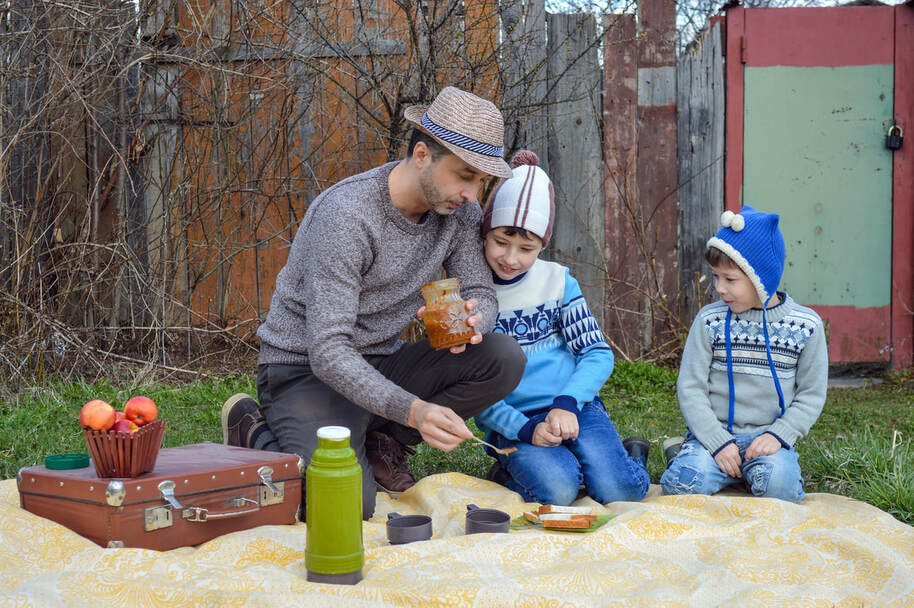Celebrating Easter's 50 Days
“Michael,” I shouted, “your time’s up! Come out of there!” My frustration was building as I stood in front of the inflated carnival castle filled with small children jumping and bouncing to their hearts’ delight. My 3-year-old son, Michael, had been in there for his allotted time, plus some, and the carnie collecting tickets was getting angry.
“Michael!” I said as sharply and authoritatively as I could. He grinned, and went back to jumping, working his way toward the back of the bouncy house, far out of the reach of his embarrassed dad.
“Michael! Right now!” I yelled.
Bounce, bounce, bounce!
“Which one’s Michael?” a little girl standing in line asked. Lots of kids were watching and lots of parents were glad he was my kid instead of theirs. Sighing, I handed over another ticket, and went in after my bouncing bundle of joy. Michael that day was indeed experiencing pure joy, rebelling against all attempts to cut it short. How can such joy be contained in a mere few minutes? How can it be lived by a stopwatch?
Children are not the only ones among us to experience pure joy and want it to last. Surely the first disciples experienced it with Christ’s Resurrection. It’s the same joy we sometimes see on the faces of the newly baptised at the Easter Vigil, as they are washed clean of sin and rise to a new life of grace. It’s a joy that can’t be contained in just a moment. That’s why the Church, from as early as the third century, let the Easter joy overflow into a 50-day season from Easter to Pentecost, in which kneeling in prayer was forbidden and the newly baptised delved into the meaning of what they had experienced.
“Michael!” I said as sharply and authoritatively as I could. He grinned, and went back to jumping, working his way toward the back of the bouncy house, far out of the reach of his embarrassed dad.
“Michael! Right now!” I yelled.
Bounce, bounce, bounce!
“Which one’s Michael?” a little girl standing in line asked. Lots of kids were watching and lots of parents were glad he was my kid instead of theirs. Sighing, I handed over another ticket, and went in after my bouncing bundle of joy. Michael that day was indeed experiencing pure joy, rebelling against all attempts to cut it short. How can such joy be contained in a mere few minutes? How can it be lived by a stopwatch?
Children are not the only ones among us to experience pure joy and want it to last. Surely the first disciples experienced it with Christ’s Resurrection. It’s the same joy we sometimes see on the faces of the newly baptised at the Easter Vigil, as they are washed clean of sin and rise to a new life of grace. It’s a joy that can’t be contained in just a moment. That’s why the Church, from as early as the third century, let the Easter joy overflow into a 50-day season from Easter to Pentecost, in which kneeling in prayer was forbidden and the newly baptised delved into the meaning of what they had experienced.
Our ancestors found great symbolic meaning in these 50 days of Easter. For example, 50 days is seven weeks — a week of weeks plus one day. That extra day was the Eighth Day, the same name they gave to Sunday — the day of resurrection, the day that symbolized eternity. It’s not just the start of a new seven-day week but the beginning of a whole new creation. Fifty days is also just about one-seventh of the whole year, so these 50 days hold the same relationship to the year as Sunday does to the week. That’s why the 50 days of Easter are known as the Great Sunday of the entire year.
And there’s more. Easter, like Christmas, has an octave, and the eight days from Easter Sunday to Divine Mercy Sunday are celebrated as one great day, the Sunday (so to speak) of the Easter season. In the early Church the newly baptised wore their white baptismal garments throughout this week, and after Christians gained power, this whole week was a legal holiday in many parts of the Roman Empire.
While 50 days of unmitigated joy seems hard for us to sustain today, the season still has meaning. It’s the time when we are meant to experience what it means when we say Christ is risen. It’s the season when we hear and ponder the beginnings of our Church, the gifts of the Spirit, and the meaning and mission of discipleship, on what joining in the Eucharist commits us to be and do. For no matter how glorious this 50-day taste of the heavenly banquet is meant to be, God eventually calls us out of the celebration and reminds us to move on and live what we’ve celebrated in all the moments of our lives.
And there’s more. Easter, like Christmas, has an octave, and the eight days from Easter Sunday to Divine Mercy Sunday are celebrated as one great day, the Sunday (so to speak) of the Easter season. In the early Church the newly baptised wore their white baptismal garments throughout this week, and after Christians gained power, this whole week was a legal holiday in many parts of the Roman Empire.
While 50 days of unmitigated joy seems hard for us to sustain today, the season still has meaning. It’s the time when we are meant to experience what it means when we say Christ is risen. It’s the season when we hear and ponder the beginnings of our Church, the gifts of the Spirit, and the meaning and mission of discipleship, on what joining in the Eucharist commits us to be and do. For no matter how glorious this 50-day taste of the heavenly banquet is meant to be, God eventually calls us out of the celebration and reminds us to move on and live what we’ve celebrated in all the moments of our lives.
How can a family sustain this “Easter spirit” of celebration all the way to Pentecost? Here are fifty ways to celebrate the fifty days. But don’t try to do them all!
Each week, just pick a few ideas that seem right for you.
1. Use a special candle at family meals to recall the light of Christ.
2. Every day, read together from the Easter story: Matthew 28; Mark 16; Luke 24; John 20-21.
3. Plan fun family activities—one for every week of Easter.
4. Put up a sign or banner that proclaims, “He is risen!”
5. Was anyone received into the Church during your parish Easter Vigil? Have them over.
6. Add an “alleluia” song—or three alleluias—to your grace before meals.
7. Put on an Easter play. Invite relatives and friends to a performance.
8. Make a poster of a life-giving cross. Add paper flowers and leaves to it throughout Easter.
9. Celebrate new life by doing something as a family to support unborn children and their parents.
10. Keep fresh flowers around.
11. Use the old Easter greeting and response: “Christ is risen! – He is risen indeed!”
12. Visit a lonely neighbour or do some other family act of kindness to express thanks for the resurrection.
13. Talk about baptism. Tell stories of family members’ baptisms.
14. Plan a family outing to a river, lake, stream, or ocean.
15. Drape your crucifixes and crosses with a strip of white cloth.
16. Make cookies in the shapes of Easter symbols. Freeze some to serve throughout the season.
17. Learn how other cultures celebrate Easter. Try out some of their customs and foods.
18. Make cards announcing the good news of the resurrection.
19. Use a special container for newly blessed water from church. Show your kids how to use holy water.
20. Throw some water balloons!
21. Listen to Handel’s Messiah and other Easter music.
22. Read about the Emmaus disciples (Luke 24:13-35); take a family walk.
23. What about a short trip to an interesting shrine or church?
24. Place a resurrection icon or picture in a place of honour.
25. Discuss what it means to be Christ’s “witnesses” (Luke 24:48)? Help each family member to see that their witness matters.
12. Visit a lonely neighbour or do some other family act of kindness to express thanks for the resurrection.
13. Talk about baptism. Tell stories of family members’ baptisms.
14. Plan a family outing to a river, lake, stream, or ocean.
15. Drape your crucifixes and crosses with a strip of white cloth.
16. Make cookies in the shapes of Easter symbols. Freeze some to serve throughout the season.
17. Learn how other cultures celebrate Easter. Try out some of their customs and foods.
18. Make cards announcing the good news of the resurrection.
19. Use a special container for newly blessed water from church. Show your kids how to use holy water.
20. Throw some water balloons!
21. Listen to Handel’s Messiah and other Easter music.
22. Read about the Emmaus disciples (Luke 24:13-35); take a family walk.
23. What about a short trip to an interesting shrine or church?
24. Place a resurrection icon or picture in a place of honour.
25. Discuss what it means to be Christ’s “witnesses” (Luke 24:48)? Help each family member to see that their witness matters.
26. Wear more white, or even gold! They’re the season’s special colours.
27. Pray the Liturgy of the Hours together in the morning or evening.
28. If your family likes to sing and play instruments, have people over for a musical Easter celebration.
29. Read about the disciples’ amazing catch of fish (John 21:1-14). Then go fishing together.
30. Or imitate Peter, and go swimming (John 21:7).
31. The Sunday after Easter is Divine Mercy Sunday. Explore this relatively new devotion (www.marian.org/divinemercy).
32. Talk about how the disciples hid (John 20:19) until the Spirit’s coming at Pentecost. Follow up by playing hide and seek.
33. Plant some seeds.
34. Honour the risen Lord’s mother by learning about “Mary gardens”.
35. Read Luke 24:50-53 or Acts 1:6-11. Ask family members to imagine themselves present at Jesus’ ascension. How would they have felt about it?
36. Watch a movie with an Easter theme.
37. Just before his ascension, Jesus blessed the disciples. Pray Numbers 6:24-26 together as a way of communicating his blessing to one another.
38. On Ascension Thursday, choose a family intention. Make the nine days till Pentecost a novena to the Holy Spirit.
39. Add some Pentecost red (for fire) to your Easter decorations.
40. Read Acts 2, the Spirit’s coming at Pentecost. Read it in all the languages family members speak! (See the Bible translations at www.biblegateway.com/languages).
27. Pray the Liturgy of the Hours together in the morning or evening.
28. If your family likes to sing and play instruments, have people over for a musical Easter celebration.
29. Read about the disciples’ amazing catch of fish (John 21:1-14). Then go fishing together.
30. Or imitate Peter, and go swimming (John 21:7).
31. The Sunday after Easter is Divine Mercy Sunday. Explore this relatively new devotion (www.marian.org/divinemercy).
32. Talk about how the disciples hid (John 20:19) until the Spirit’s coming at Pentecost. Follow up by playing hide and seek.
33. Plant some seeds.
34. Honour the risen Lord’s mother by learning about “Mary gardens”.
35. Read Luke 24:50-53 or Acts 1:6-11. Ask family members to imagine themselves present at Jesus’ ascension. How would they have felt about it?
36. Watch a movie with an Easter theme.
37. Just before his ascension, Jesus blessed the disciples. Pray Numbers 6:24-26 together as a way of communicating his blessing to one another.
38. On Ascension Thursday, choose a family intention. Make the nine days till Pentecost a novena to the Holy Spirit.
39. Add some Pentecost red (for fire) to your Easter decorations.
40. Read Acts 2, the Spirit’s coming at Pentecost. Read it in all the languages family members speak! (See the Bible translations at www.biblegateway.com/languages).
41. Decorate a cake with Pentecost flames and other symbols to celebrate the birthday of the church.
42. Talk about the seven gifts of the Holy Spirit (see Isaiah 11 and 1 Corinthians 12; also the Catechism of the Catholic Church, 1830-1832).
43. Make a Pentecost hanging or mobile that features a dove and tongues of fire.
44. Learn a prayer to the Holy Spirit to use in your family prayer time.
45. Play “twenty questions”: Have someone choose a Bible character or thing from the Easter and Pentecost stories. The group gets twenty questions (yes or no answers only) to guess the right answer.
46. List the nine fruits of the Holy Spirit (Galatians 5:22-23; Catechism, 1832) on separate slips of paper. Have each family member randomly select a fruit to cultivate.
47. Fly a kite to celebrate the wind of the Holy Spirit.
48. Find ways to make Sunday meals special during the Easter season.
49. Continue the “special Sunday meal” tradition to celebrate Jesus’ resurrection all year.
50. Discuss why Sunday is holy (see John Paul II’s Apostolic Letter, On Keeping the Lord’s Day Holy; Catechism, 2174-2195). Decide how you can keep the Lord’s Day as a family.
42. Talk about the seven gifts of the Holy Spirit (see Isaiah 11 and 1 Corinthians 12; also the Catechism of the Catholic Church, 1830-1832).
43. Make a Pentecost hanging or mobile that features a dove and tongues of fire.
44. Learn a prayer to the Holy Spirit to use in your family prayer time.
45. Play “twenty questions”: Have someone choose a Bible character or thing from the Easter and Pentecost stories. The group gets twenty questions (yes or no answers only) to guess the right answer.
46. List the nine fruits of the Holy Spirit (Galatians 5:22-23; Catechism, 1832) on separate slips of paper. Have each family member randomly select a fruit to cultivate.
47. Fly a kite to celebrate the wind of the Holy Spirit.
48. Find ways to make Sunday meals special during the Easter season.
49. Continue the “special Sunday meal” tradition to celebrate Jesus’ resurrection all year.
50. Discuss why Sunday is holy (see John Paul II’s Apostolic Letter, On Keeping the Lord’s Day Holy; Catechism, 2174-2195). Decide how you can keep the Lord’s Day as a family.
See original articles by Dan Connors and from The Word Among Us
Images from Unsplash and Pixabay. Used under license/with permission.
Images from Unsplash and Pixabay. Used under license/with permission.






